As we slide into Fall, the market is beginning it’s seasonal slowdown, but we still closed 1,133 Residential properties across Washington and Benton Counties in August 2020.
As of September 8th, we only have 1,142 in the market, so we still only have about 1 Month of Supply right now.
Again this month, we broke a Pricing Record with an average sale price of $288,947, up from $284,942 in July.
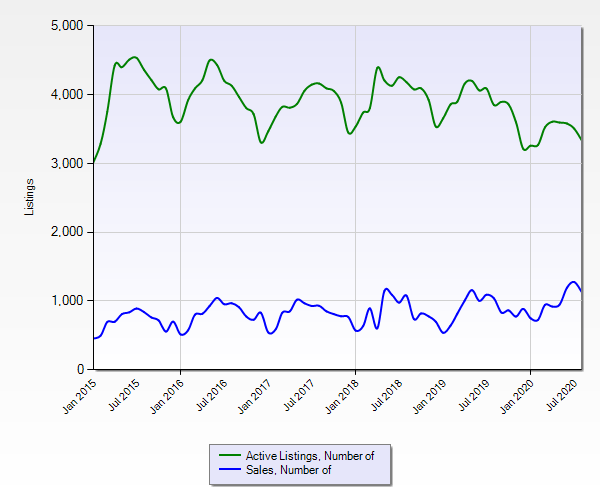
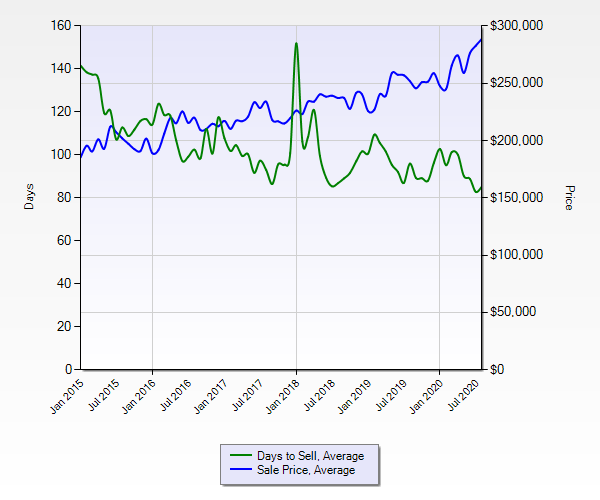
For 4 months now, New Pending sales have outpaced New Listings entering the market every week. This lower supply and higher demand is ensuring that multiple offers are being placed on most properties within a very short amount of time. One of my listings got a bidding war resulting in a signed contract within 11 hours of it hitting the market!
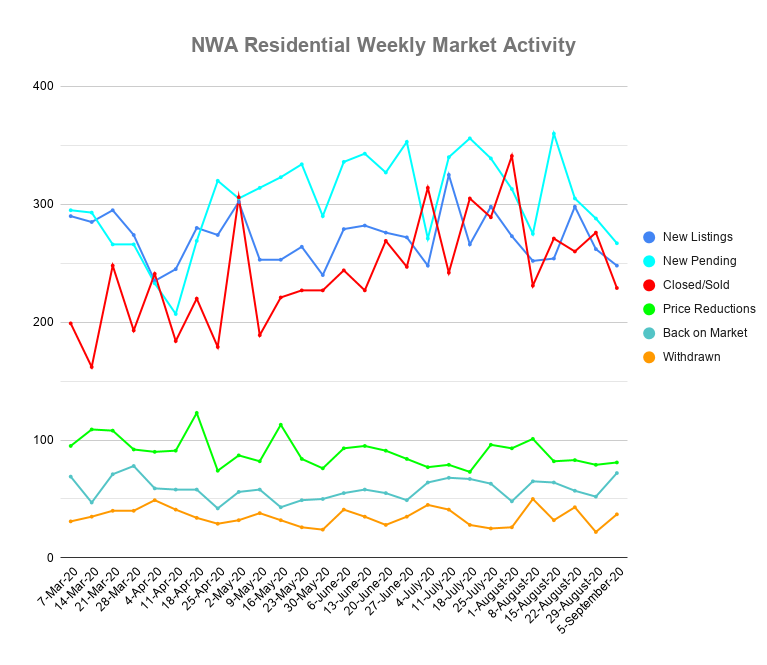
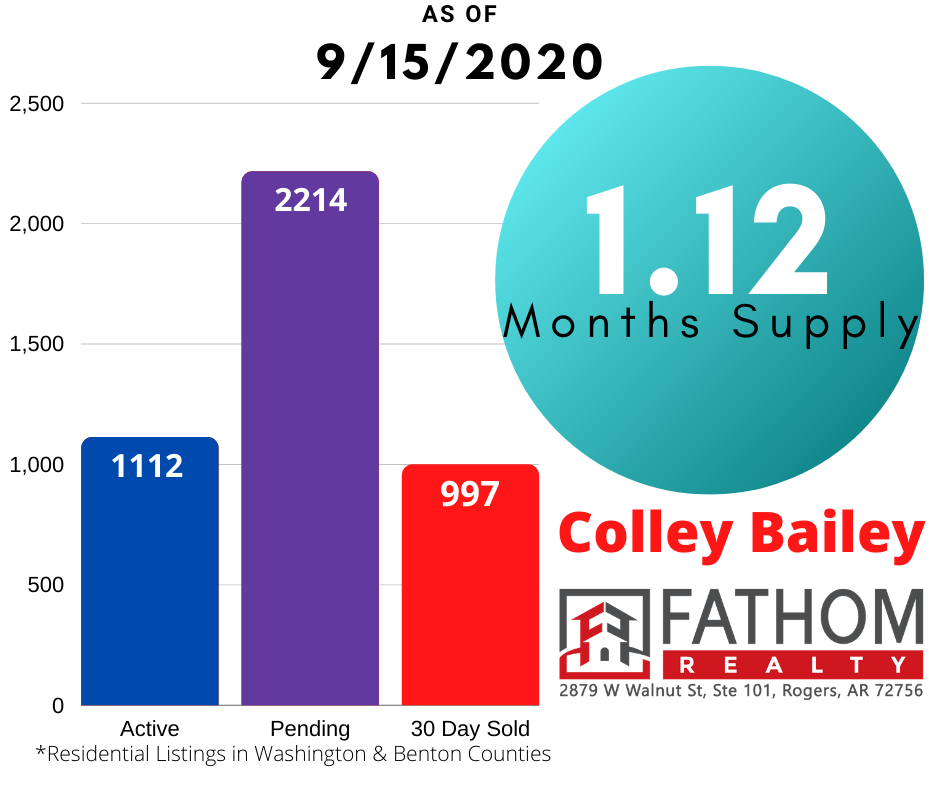
Major Forces
Nationally, the housing sector has been a shining diamond diamond in an otherwise dull economic outlook. The second quarter of 2020 was the worst quarter in American history with an annualized contraction in GDP (Gross Domestic Product) of 32.9%. Wall Street bounced back over the summer, but has been losing steam as of late. The Federal Reserve has committed to keeping interest rates low for the foreseeable future, along with buying corporate bonds and other risky assets.
Most of the rise in Real Estate prices can be readily traced to the lowering of interest rates keeping mortgage payments affordable, even when closing at larger and larger purchase prices. The lower interest has increased the buying power of average buyers, even though their income and debt ratios may have remained unchanged. However, this rate induced price bump can only go so far before it reaches an equilibrium with peoples debt-to-income ratios, and then home prices will stagnate. We may be close to that stagnation point now.
Jobs and Relocation
Jobs are a main driver of housing sales and affordability. The U.S. Bureau of Labor Statistics reported the national unemployment rate at 10.5% in July. (July was the latest month of data available as I’m writing this article.) However, here in NWA (“Fayetteville area” in the chart below), we had bounced back to 5.7% by July 2020. That’s almost half the national average, so our area is holding fairly strong relative to the rest of the country as a whole.
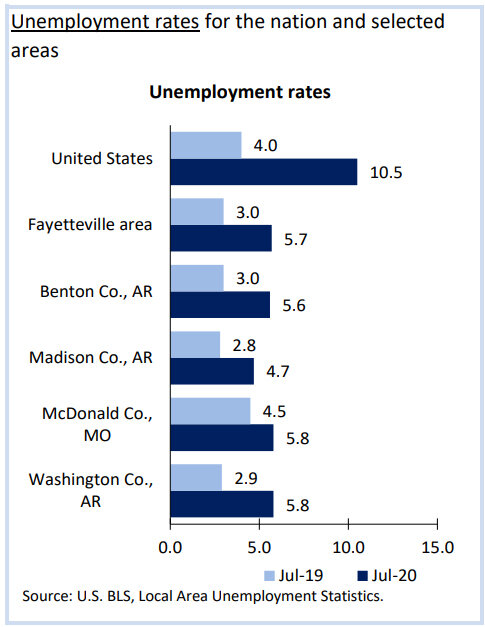
BLS: Local Area Unemployment Statistics
Area: Fayetteville-Springdale-Rogers, AR-MO Metropolitan Statistical Area
Area Type: Metropolitan areas
State/Region/Division: Arkansas

Another reason for the housing market to have escaped much of the downfall of other sectors is that, by and large, most potential buyers have kept their jobs and incomes. The hospitality, restaurant, and front line retail workers were the hardest during the pandemic, and many of these workers were in lower paid positions and were renting their dwellings. So, the buyer pool for Real Estate didn’t seem to change that much.
Governmental Response
The $600 enhanced unemployment that was keeping many Americans afloat during early Summer ended on July 31st. As of now, Congress has failed to come to terms on any other agreement for addition stimulus or aid packages. A presidential memorandum has extended the enhanced unemployment assistance at about $300 per week for 6 weeks. Beyond these measures, it isn’t clear what additional response, if anything, we should expect from the government at this time.
With stocks faltering, real estate potentially peaking, and continuing unemployment problems, consumer spending will likely fall further. This is a reality we must prepare for. The bigger implication of continued low levels of consumer spending is more job losses as companies can’t meet their payrolls and overhead expenses if they aren’t selling as much. There is a chance that a new wave of job losses could result, no longer because of COVID, but because of the lackluster economy itself.
Evictions and Foreclosure
Part of the initial governmental response was protections on evictions and foreclosures. This was done to keep people in their homes and rentals as long as possible, and it has already strained our banking system and many landlords across the US. On July 31st, the eviction moratorium was lifted, and some evictions were enacted throughout August. Then, on September 4, President Trump issued an act to temporarily halt residential evictions to prevent the further spread of COVID-19 through December 31, 2020.
With all the uncertainty in residential rentals, I have seen more and more landlords putting their properties up for sale. When these eviction moratoriums finally expire, I do expect many more properties to hit the market.
Likewise, Forebearances were put in place for homeowners who had trouble paying their mortgage, which had an initial period of 6 months and can be extended for another 6 months. The first deadline hits this fall, around October, and could lead to more homes being put on the market in an attempt to sell the house to avoid being foreclosed upon. The second and more definite deadline will be in the Spring of 2021.
Also, as long as homeowners are able to make payments at that time, those with federally backed mortgages have several flexible repayment options:
- Pay back the balance owed and resume normal payments
- Add an additional repayment plan to catch up
- Restructure the debt with a loan modification to the interest rate and/or length of term to lower payments
- Defer the missed payments to the end of the loan, or until the property is sold
As you can see, most of the affected homeowners will actually have good protections in place against foreclosure. It’s possible that we could avoid large-scale foreclosures like we saw during the last financial/housing crisis in 2008/2009. However, I do believe we will see an influx of homes being released into the market next year as landlords cash in on their portfolios and some struggling homeowners list their homes to avoid foreclosure. That increased inventory should flatten price growth and could potentially lead to lower prices if economic conditions don’t improve.
What it all Means for You
If you’ve been thinking of selling your home, PLEASE listen to me. We may be close to a price peak right now. We don’t know exactly how all this will play out. Hopefully, our record high prices can withstand the economic storm that has been brewing during this pandemic.
However, that may not be the case, and we may see prices fall later this year or next year. You may not be able to sell your home at these kinds of prices if you miss this window of opportunity.
If we do see a price decline in Real Estate, there’s no telling how long it may take to recover. This decline won’t look exactly like the last Recession, but there are lessons to be learned from it. In that one, it took Real Estate 7 to 8 years to get back to the previous highs.
Are you prepared to stay in your current home for the next 7-10 years? Is it the best possible living situation for you and your family? If not, let’s chat. I want you to make it through in the best possible position.
I book Free Strategy Sessions for all my clients. No pressure or obligation, but I’d be happy to help you put a solid plan in place to guide you through these uncertain times.
Would it make sense to chat for a few minutes?
Just book a FREE Strategy Session with me Here to block out your own time on my calendar.
You could also Send me a message or give me a call today! (479) 777-3379
